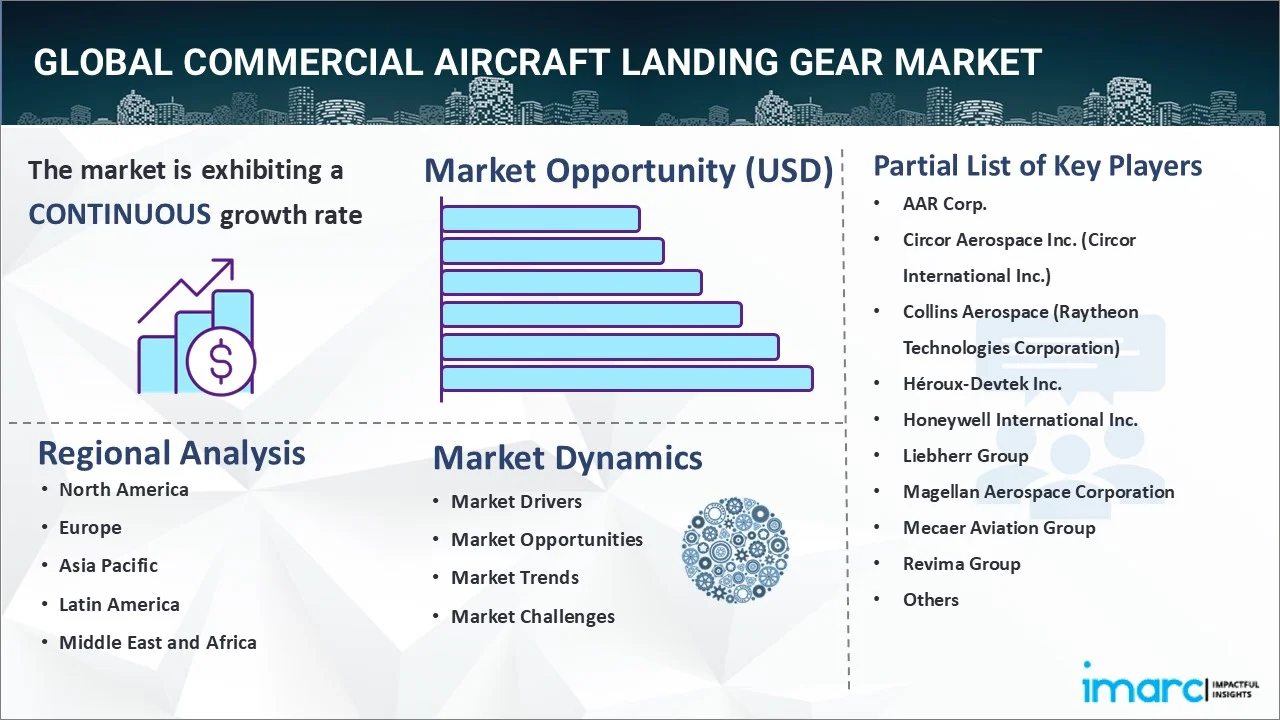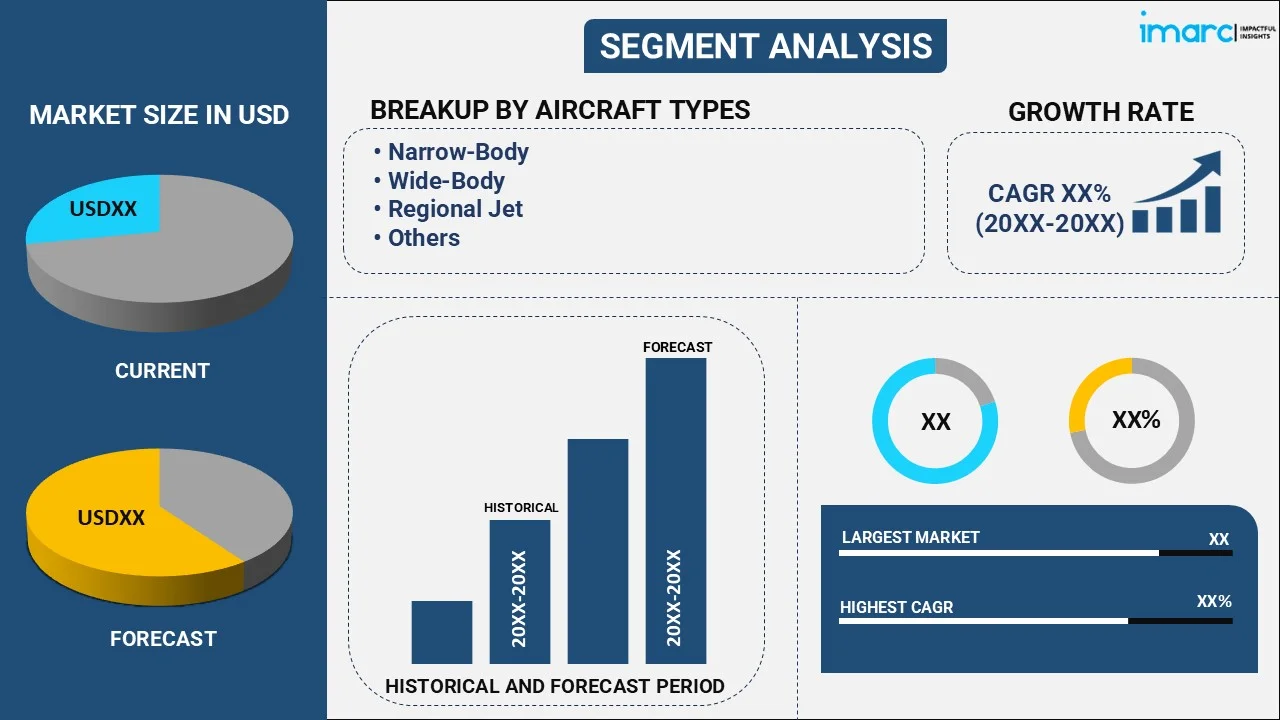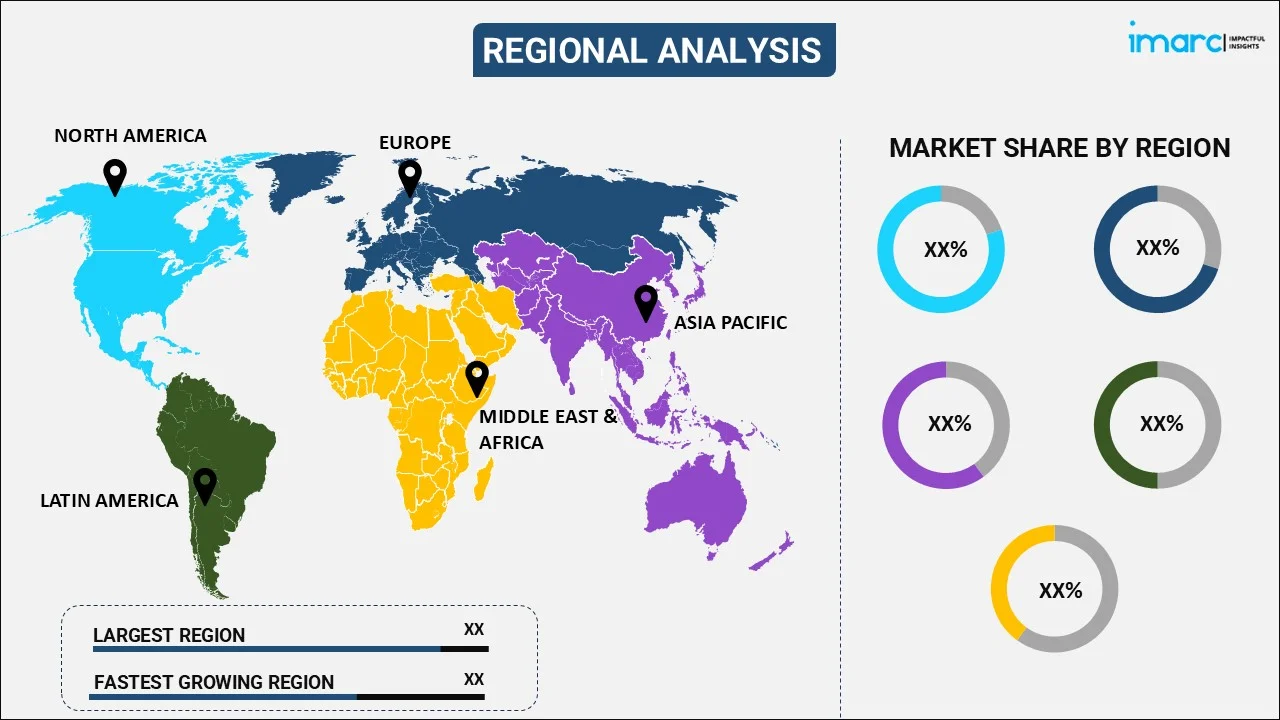
Commercial Aircraft Landing Gear Market Report by Aircraft Type (Narrow-Body, Wide-Body, Regional Jet, and Others), Landing Gear Types (Main Landing Gear, Nose Landing Gear), Arrangement Type (Tricycle, Tandem, Tailwheel), and Region 2025-2033
Commercial Aircraft Landing Gear Market Size:
The global commercial aircraft landing gear market size reached USD 9.8 Billion in 2024. Looking forward, IMARC Group expects the market to reach USD 18.6 Billion by 2033, exhibiting a growth rate (CAGR) of 6.95% during 2025-2033. The increasing air travel popularity, the expanding global aviation sector, rising aircraft production, technological advancements in lightweight materials, improved safety standards, and fuel efficiency, fleet modernization, aircraft upgrades, and the growing need for durable and efficient landing systems are some of the major factors propelling the market growth.
|
Report Attribute
|
Key Statistics
|
|---|---|
|
Base Year
|
2024
|
|
Forecast Years
|
2025-2033
|
|
Historical Years
|
2019-2024
|
|
Market Size in 2024
|
USD 9.8 Billion |
|
Market Forecast in 2033
|
USD 18.6 Billion |
| Market Growth Rate 2025-2033 | 6.95% |
Commercial Aircraft Landing Gear Market Analysis:
- Major Market Drivers: The increasing demand for air travel, particularly in emerging markets, which boosts aircraft production represents the major driver in the market. Airlines are expanding their fleets to meet growing passenger numbers and replacing aging aircraft, thus further driving the need for new landing gear systems. Significant technological advancements in lightweight materials like titanium and carbon composites enhance fuel efficiency and durability, making these systems more attractive to aircraft manufacturers and airlines.
- Key Market Trends: The widespread adoption of advanced material and manufacturing techniques aimed at reducing aircraft weight and improving performance represents the key trends in the commercial aircraft landing gear market. Automation and smart technologies are being integrated into landing gear systems to enhance maintenance and operational efficiency, which is expected to contribute to the commercial aircraft landing gear market growth.
- Geographical Trends: Asia Pacific accounts for the largest region in the market across the globe. Rapid growth in air travel, rising disposable incomes, and expanding tourism are driving the market growth across the region. The increasing aircraft production by regional manufacturers, fleet expansion by airlines, and demand for more fuel-efficient, lightweight landing gear systems further boost the market.
- Competitive Landscape: Some of the major market players in the commercial aircraft landing gear industry include AAR Corp., Circor Aerospace Inc. (Circor International Inc.), Collins Aerospace (Raytheon Technologies Corporation), Héroux-Devtek Inc., Honeywell International Inc., Liebherr Group, Magellan Aerospace Corporation, Mecaer Aviation Group, Revima Group, Safran S.A., Sumitomo Precision Products Co. Ltd. and Triumph Group Inc., among many others.
- Challenges and Opportunities: The market faces several challenges including high development costs, stringent safety regulations, and the need for durable, lightweight materials that can withstand extreme conditions. However, the market also faces various opportunities such as the increasing global air travel demand, especially in emerging markets, and the growth of low-cost carriers expanding fleets.

Commercial Aircraft Landing Gear Market Trends:
Growing Air Travel Demand
The rising number of air passengers globally, particularly in emerging markets, is driving increased aircraft production and fleet expansions, thus boosting the demand for landing gear systems. According to industry reports, the flight frequency counter shows the number of (one-way) flights in the schedule from 1st January 2024 to the end of the current week. With 27,099,697 flights in total to the end of this week, the average number of commercial flights per day is 101,878. According to the Federal Aviation Administration, every day, FAA's Air Traffic Organization (ATO) provides service to more than 45,000 flights and 2.9 million airline passengers across more than 29 million square miles of airspace. The growing air traffic is likely to create a positive commercial aircraft landing gear market outlook.
Significant Technological Advancements
Innovations in lightweight materials like titanium and composites improve fuel efficiency, durability, and performance, making landing gear systems more attractive to manufacturers and airlines. For instance, in June 2023, TISICS, a company pioneering ceramic fiber-reinforced metal composite materials, made strides in the commercial aviation sector by unveiling Light Land, the company’s lightweight landing gear for commercial aircraft. The innovation will reportedly deliver CO2 savings by 2030, as well as demonstrate improved fuel efficiency, helping to propel the aerospace industry toward its goal of achieving net zero emissions by 2050. Currently, 50% of an aircraft is comprised of metal component. TISICS’ sustainable lightweight and high-strength hybrid alternative, developed as part of a project backed by £2.5 million in research and development (R&D) funding from UK Research and Innovation (UKRI) and Innovate UK, in collaboration with Safran Landing Systems (Vélizy-Villacoublay, France), is said to be the world’s largest fiber-reinforced metal composite component for commercial aircraft.
Rising Fleet Modernization
Airlines are increasingly replacing aging aircraft with newer, more fuel-efficient models, creating demand for advanced, efficient landing gear systems to support modern aviation needs. For instance, in September 2024, Air India, India’s leading global airline, today announced the commencement of its over US$400m refit program for a phased revamp of 67 legacy aircraft in its fleet. This refit will lead to a refresh of the product to the new Air India experience, with a modern three-cabin configuration, new seats, new carpets, curtains, and upholstery. The refit program will start with the 27 narrowbody Airbus A320neo aircraft, followed by the 40 widebody Boeing aircraft.
Commercial Aircraft Landing Gear Market Segmentation:
IMARC Group provides an analysis of the key trends in each segment of the market, along with forecasts at the global, regional, and country levels for 2025-2033. Our report has categorized the market based on aircraft type, landing gear types, and arrangement type.
Breakup by Aircraft Type:

- Narrow-Body
- Wide-Body
- Regional Jet
- Others
Narrow-body accounts for the majority of the market share
The report has provided a detailed breakup and analysis of the market based on the aircraft type. This includes narrow-body, wide-body, regional jet, and others. According to the commercial aircraft landing gear market report, the narrow body represented the largest segment.
The growth of narrow-body aircraft in the market is driven by the increasing demand for short- and medium-haul flights, which require cost-effective and efficient aircraft. Airlines prefer narrow-body aircraft due to their lower fuel consumption, reduced maintenance costs, and ability to serve high-frequency routes. Technological advancements in landing gear design, focusing on lightweight materials and durability, further enhance the performance of these aircraft. Additionally, expanding low-cost carriers and rising air travel in emerging markets contribute to the demand for narrow-body aircraft landing gear systems.
Breakup by Landing Gear Types:
- Main Landing Gear
- Nose Landing Gear
Main landing gear holds the largest share of the industry
A detailed breakup and analysis of the market based on the landing gear types have also been provided in the report. This includes the main landing gear and nose landing gear. According to the report, main landing gear accounted for the largest market share.
The main landing gear accounts for the largest share of the commercial aircraft landing gear market because it bears most of the aircraft's weight during landing, takeoff, and ground operations. It requires stronger, more durable components, which drives higher demand for advanced materials and technologies. Additionally, the main landing gear's critical role in ensuring aircraft stability and safety necessitates regular maintenance and upgrades, further boosting its market share. As aircraft size and weight increase, demand for robust main landing gear systems continues to grow.
Breakup by Arrangement Type:
- Tricycle
- Tandem
- Tailwheel
Tricycle represents the leading market segment
The report has provided a detailed breakup and analysis of the market based on the arrangement type. This includes tricycle, tandem, and tailwheel. According to the report, tricycle represented the largest segment.
The tricycle arrangement holds the largest segment in the market due to its superior stability, maneuverability, and widespread adoption in modern aircraft designs. Featuring two main wheels and a nose wheel, this configuration enhances weight distribution during takeoff and landing, improving safety and control. Tricycle landing gear also allows better ground visibility for pilots and easier taxiing, which is driving the commercial aircraft landing gear demand. Its efficiency, coupled with its compatibility with both narrow- and wide-body aircraft, makes it the preferred choice for commercial aviation.
Breakup by Region:

- North America
- United States
- Canada
- Asia-Pacific
- China
- Japan
- India
- South Korea
- Australia
- Indonesia
- Others
- Europe
- Germany
- France
- United Kingdom
- Italy
- Spain
- Russia
- Others
- Latin America
- Brazil
- Mexico
- Others
- Middle East and Africa
Asia Pacific leads the market, accounting for the largest commercial aircraft landing gear market share
The report has also provided a comprehensive analysis of all the major regional markets, which include North America (the United States and Canada); Europe (Germany, France, the United Kingdom, Italy, Spain, Russia, and others); Asia Pacific (China, Japan, India, South Korea, Australia, Indonesia, and others); Latin America (Brazil, Mexico, and others); and the Middle East and Africa. According to the report, Asia Pacific represents the largest regional market for commercial aircraft landing gear.
Rapid urbanization, increasing disposable incomes, and a growing middle-class population are all fueling the demand for air travel across the region. Airlines are expanding their fleets to meet rising passenger numbers, leading to increased aircraft production and landing gear demand. Additionally, regional low-cost carriers are flourishing, further driving the market. Technological advancements in lightweight, fuel-efficient landing gear systems align with the region's focus on sustainability. For instance, in August 2024, Boeing and AIESL announced partnership to provide in-country overhaul services of critical components for the Indian Navy’s fleet of 12 Boeing P-8I aircraft. As part of the partnership, the first landing gear overhaul of a P-8I aircraft was recently completed at INS Rajali. This is a first in India and reflects the growth in India’s Indigenous capabilities for undertaking complex Maintenance, Repair, and Overhaul (MRO) services.
Competitive Landscape:
- The market research report has also provided a comprehensive analysis of the competitive landscape in the market. Detailed profiles of all major companies have also been provided. Some of the major market players in the commercial aircraft landing gear industry include AAR Corp., Circor Aerospace Inc. (Circor International Inc.), Collins Aerospace (Raytheon Technologies Corporation), Héroux-Devtek Inc., Honeywell International Inc., Liebherr Group, Magellan Aerospace Corporation, Mecaer Aviation Group, Revima Group, Safran S.A., Sumitomo Precision Products Co. Ltd. and Triumph Group Inc.
(Please note that this is only a partial list of the key players, and the complete list is provided in the report.)
- The market is highly competitive, with key players including Safran Landing Systems, Collins Aerospace, Liebherr Aerospace, and Héroux-Devtek. According to the commercial aircraft landing gear market forecast, these companies focus on innovation, lightweight materials, and advanced manufacturing techniques to enhance performance and fuel efficiency which is further driving the market growth. Partnerships with aircraft manufacturers like Boeing and Airbus are crucial for market dominance. Smaller firms and regional players also compete by offering specialized solutions and maintenance services, while market consolidation through mergers and acquisitions strengthens the position of leading companies. For instance, in January 2023, ASL Aviation Holdings and AMETEK MRO AEM announced a new agreement for the provision of landing gear services for ASL’s European fleet of B737 Next Generation and Classic aircraft.
Commercial Aircraft Landing Gear Market News:
- In October 2023, Supernal, Hyundai Motor Group's (HMG) Advanced Air Mobility (AAM) company, Hyundai WIA, a global automotive and aerospace parts manufacturer, and Mecaer Aviation Group, an Italy-based global aeronautical company, announced a partnership to design and manufacture landing gear systems for electric vertical takeoff and landing (eVTOL) vehicles. Hyundai WIA specializes in mass manufacturing and precision machine tools, while Mecaer is experienced in designing and building aerospace-grade landing gear systems.
- In May 2024, Oxfordshire-based Transense Technologies officially joined the LANDOne project with Airbus to support the development of next-generation landing systems technology. LANDOne is a £37.8 million project to design lighter, lower maintenance landing gear systems.
Commercial Aircraft Landing Gear Market Report Scope:
| Report Features | Details |
|---|---|
| Base Year of the Analysis | 2024 |
| Historical Period | 2019-2024 |
| Forecast Period | 2025-2033 |
| Units | Billion USD |
| Scope of the Report | Exploration of Historical Trends and Market Outlook, Industry Catalysts and Challenges, Segment-Wise Historical and Future Market Assessment:
|
| Aircraft Types Covered | Narrow-Body, Wide-Body, Regional Jet, Others |
| Landing Gear Types Covered | Main Landing Gear, Nose Landing Gear |
| Arrangement Types Covered | Tricycle, Tandem, Tailwheel |
| Regions Covered | Asia Pacific, Europe, North America, Latin America, Middle East and Africa |
| Countries Covered | United States, Canada, Germany, France, United Kingdom, Italy, Spain, Russia, China, Japan, India, South Korea, Australia, Indonesia, Brazil, Mexico |
| Companies Covered | AAR Corp., Circor Aerospace Inc. (Circor International Inc.), Collins Aerospace (Raytheon Technologies Corporation), Héroux-Devtek Inc., Honeywell International Inc., Liebherr Group, Magellan Aerospace Corporation, Mecaer Aviation Group, Revima Group, Safran S.A., Sumitomo Precision Products Co. Ltd., Triumph Group Inc., etc. |
| Customization Scope | 10% Free Customization |
| Post-Sale Analyst Support | 10-12 Weeks |
| Delivery Format | PDF and Excel through Email (We can also provide the editable version of the report in PPT/Word format on special request) |
Key Benefits for Stakeholders:
- IMARC’s industry report offers a comprehensive quantitative analysis of various market segments, historical and current market trends, market forecasts, and dynamics of the commercial aircraft landing gear market from 2019-2033.
- The commercial aircraft landing gear market research report provides the latest information on the market drivers, challenges, and opportunities in the global market.
- The study maps the leading, as well as the fastest-growing, regional markets. It further enables stakeholders to identify the key country-level markets within each region.
- Porter's five forces analysis assists stakeholders in assessing the impact of new entrants, competitive rivalry, supplier power, buyer power, and the threat of substitution. It helps stakeholders to analyze the level of competition within the commercial aircraft landing gear industry and its attractiveness.
- The competitive landscape allows stakeholders to understand their competitive environment and provides insight into the current positions of key players in the market.
Key Questions Answered in This Report
The global commercial aircraft landing gear market was valued at USD 9.8 Billion in 2024.
We expect the global commercial aircraft landing gear market to exhibit a CAGR of 6.95% during 2025-2033.
The rising demand for commercial aircraft landing gears, such as brake system, shock absorbers, wheels, etc., to minimize the impact loads that are transmitted to the airframe is primarily driving the global commercial aircraft landing gear market.
The sudden outbreak of the COVID-19 pandemic had led to the implementation of stringent lockdown regulations across several nations, resulting in the temporary closure of numerous installation activities for commercial aircraft landing gear.
Based on the aircraft type, the global commercial aircraft landing gear market can be segmented into narrow-body, wide-body, regional jet, and others. Among these, narrow-body holds the majority of the total market share.
Based on the landing gear types, the global commercial aircraft landing gear market has been divided into main landing gear and nose landing gear, where main landing gear currently exhibits a clear dominance in the market.
Based on the arrangement type, the global commercial aircraft landing gear market can be categorized into tricycle, tandem, and tailwheel. Currently, tricycle accounts for the largest market share.
On a regional level, the market has been classified into North America, Asia-Pacific, Europe, Latin America, and Middle East and Africa, where Asia-Pacific currently dominates the global market.
Some of the major players in the global commercial aircraft landing gear market include AAR Corp., Circor Aerospace Inc. (Circor International Inc.), Collins Aerospace (Raytheon Technologies Corporation), Héroux-Devtek Inc., Honeywell International Inc., Liebherr Group, Magellan Aerospace Corporation, Mecaer Aviation Group, Revima Group, Safran S.A., Sumitomo Precision Products Co. Ltd., and Triumph Group Inc.
Need more help?
- Speak to our experienced analysts for insights on the current market scenarios.
- Include additional segments and countries to customize the report as per your requirement.
- Gain an unparalleled competitive advantage in your domain by understanding how to utilize the report and positively impacting your operations and revenue.
- For further assistance, please connect with our analysts.
 Inquire Before Buying
Inquire Before Buying
 Speak to an Analyst
Speak to an Analyst
 Request Brochure
Request Brochure
 Request Customization
Request Customization




.webp)




.webp)












